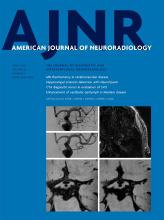Index by author
Tang, R.
- Extracranial VascularOpen AccessAssessment of Apparent Internal Carotid Tandem Occlusion on High-Resolution Vessel Wall Imaging: Comparison with Digital Subtraction AngiographyS. Chai, Z. Sheng, W. Xie, C. Wang, S. Liu, R. Tang, C. Cao, W. Xin, Z. Guo, B. Chang, X. Yang, J. Zhu and S. XiaAmerican Journal of Neuroradiology April 2020, 41 (4) 693-699; DOI: https://doi.org/10.3174/ajnr.A6452
Taree, A.
- LetterYou have accessAuthorship Trends in the American Journal of NeuroradiologyS. Emamzadehfard, A. Taree and D.M. YousemAmerican Journal of Neuroradiology April 2020, 41 (4) E22-E24; DOI: https://doi.org/10.3174/ajnr.A6463
Tellier, A.
- FELLOWS' JOURNAL CLUBAdult BrainYou have accessReliability of CT Angiography in Cerebral Vasospasm: A Systematic Review of the Literature and an Inter- and Intraobserver StudyL. Letourneau-Guillon, B. Farzin, T.E. Darsaut, M. Kotowski, F. Guilbert, M. Chagnon, A. Diouf, D. Roy, A. Weill, M. Lemus, C. Bard, M. Belair, D. Landry, L. Nico, A. Tellier, R. Jabre, C. Kauffmann and J. RaymondAmerican Journal of Neuroradiology April 2020, 41 (4) 612-618; DOI: https://doi.org/10.3174/ajnr.A6462
In Part I of this study, articles reporting the reliability of CTA up to May 2018 were systematically searched and evaluated. In Part II, 11 raters independently graded 17 arterial segments in each of 50 patients with SAH for the presence of vasospasm using a 4-category scale. Raters were additionally asked to judge the presence of any moderate/severe vasospasm and whether findings would justify augmentation of medical treatment or conventional angiography ± balloon angioplasty. The systematic review revealed few studies with heterogeneous vasospasm definitions. In Part II, the authors found interrater reliability to be moderate at best (ϰ > 0.6), even when results were stratified according to specialty and experience. They conclude that the diagnosis of vasospasm using CTA alone was not sufficiently repeatable among observers to support its general use to guide decisions in the clinical management of patients with SAH.
Tominaga, T.
- EDITOR'S CHOICENeurointerventionOpen AccessComplications of Endovascular Treatments for Brain Arteriovenous Malformations: A Nationwide SurveillanceK. Sato, Y. Matsumoto, T. Tominaga, T. Satow, K. Iihara and N. Sakai for the Japanese Registry of Neuroendovascular Therapy InvestigatorsAmerican Journal of Neuroradiology April 2020, 41 (4) 669-675; DOI: https://doi.org/10.3174/ajnr.A6470
The authors retrospectively reviewed a nationwide surveillance to identify risk factors contributing to complications and short-term clinical outcomes in the endovascular treatment of brain arteriovenous malformations. A total of 1042 endovascular procedures (788 patients) performed in 111 institutions from 2010 to 2014 were reviewed. Univariate analysis identified deep venous drainage, associated aneurysms, infratentorial location, and pre-radiosurgical embolization as statistically significant risk factors for complications. Multivariate analysis showed that embolization of brain arteriovenous malformations in the infratentorial location was significantly associated with complications.








